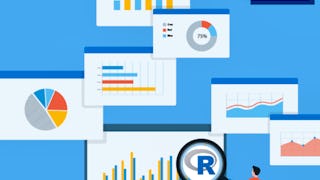The data science revolution has produced reams of new data from a wide variety of new sources. These new datasets are being used to answer new questions in way never before conceived. Visualization remains one of the most powerful ways draw conclusions from data, but the influx of new data types requires the development of new visualization techniques and building blocks. This course provides you with the skills for creating those new visualization building blocks. We focus on the ggplot2 framework and describe how to use and extend the system to suit the specific needs of your organization or team. Upon completing this course, learners will be able to build the tools needed to visualize a wide variety of data types and will have the fundamentals needed to address new data types as they come about.

Enjoy unlimited growth with a year of Coursera Plus for $199 (regularly $399). Save now.

Building Data Visualization Tools
This course is part of Mastering Software Development in R Specialization


Instructors: Roger D. Peng, PhD
12,688 already enrolled
Included with
(158 reviews)
Skills you'll gain
Details to know

Add to your LinkedIn profile
See how employees at top companies are mastering in-demand skills

Build your subject-matter expertise
- Learn new concepts from industry experts
- Gain a foundational understanding of a subject or tool
- Develop job-relevant skills with hands-on projects
- Earn a shareable career certificate

There are 5 modules in this course
Before we get started, we'll take a quick overview of the course.
What's included
1 video2 readings
Now, we'll dive into creating and customizing ggplot2 plots.
What's included
13 readings1 assignment
Mapping is a critical part of many data visualizations. During this module, we'll teach you how to create simple and dynamic maps with ggplot2 and ggmap, how to overlay data, and how to create chloropleth maps of US counties.
What's included
9 readings1 assignment
The grid package in R implements the primitive graphical functions that underly the ggplot2 plotting system. In this module, you'll learn how to work with grid to build graphics.
What's included
7 readings1 assignment
Building and modifying a theme in ggplot2 is a key feature of the ggplot2 package and system for building data graphics. In this final module, you'll learn to build a new theme and modifying existing themes with new features.
What's included
12 readings1 peer review
Earn a career certificate
Add this credential to your LinkedIn profile, resume, or CV. Share it on social media and in your performance review.
Instructors


Offered by
Explore more from Data Analysis
 Status: Free Trial
Status: Free TrialJohns Hopkins University
 Status: Free Trial
Status: Free TrialJohns Hopkins University
 Status: Free Trial
Status: Free TrialJohns Hopkins University
 Status: Free Trial
Status: Free TrialJohns Hopkins University
Why people choose Coursera for their career




Learner reviews
158 reviews
- 5 stars
43.67%
- 4 stars
27.21%
- 3 stars
16.45%
- 2 stars
5.69%
- 1 star
6.96%
Showing 3 of 158
Reviewed on Jun 22, 2020
It is a good course. The only downside is that if you are a beginner level R programmer and want to upskill, you will need to do an extensive search to complete this course.
Reviewed on Jul 31, 2017
very useful, especially the final practical exam.not 5 score because I think more time should have been spent in more modern interactive charts
Reviewed on Apr 30, 2018
It is a very good course, but feels a bit more hands-off than the other 3 preceding courses in the Mastering Software Development in R certificate.
Frequently asked questions
To access the course materials, assignments and to earn a Certificate, you will need to purchase the Certificate experience when you enroll in a course. You can try a Free Trial instead, or apply for Financial Aid. The course may offer 'Full Course, No Certificate' instead. This option lets you see all course materials, submit required assessments, and get a final grade. This also means that you will not be able to purchase a Certificate experience.
When you enroll in the course, you get access to all of the courses in the Specialization, and you earn a certificate when you complete the work. Your electronic Certificate will be added to your Accomplishments page - from there, you can print your Certificate or add it to your LinkedIn profile.
Yes. In select learning programs, you can apply for financial aid or a scholarship if you can’t afford the enrollment fee. If fin aid or scholarship is available for your learning program selection, you’ll find a link to apply on the description page.
More questions
Financial aid available,
¹ Some assignments in this course are AI-graded. For these assignments, your data will be used in accordance with Coursera's Privacy Notice.





